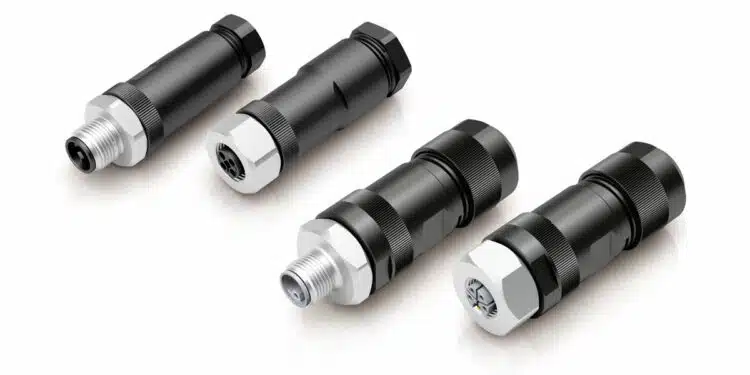binder introduces new M12 L- and T-coded connectors featuring stainless steel locking mechanisms, ensuring the highest levels of reliability and durability in demanding industrial environments.
With the launch of the latest 813 (T-coded) and 823 (L-coded) series field attachable M12 connectors, binder is expanding its portfolio with particularly robust solutions.
The connectors have a robust stainless steel locking mechanism, have an IP67 degree of protection and an outstanding mechanical service life of over 100 mating cycles.
The 813 series offers a pole count of 4, while the 823 series offers pole counts of 4 and 4+FE.
Both variants are designed for cable diameters of 6-13 mm. Another advantage is their high temperature resistance: they are designed for an operating range of -40 °C to +105 °C and are therefore ideal for modern industrial applications.
Reliability in Harsh Environments
In today’s industrial landscape, characterised by advancing automation and the growing need for robust and space-saving connection solutions, the M12 series from binder is establishing new standards. The new L- and T-coded connectors not only impress with their high reliability and durability, but also with their impressive resistance to extreme conditions. In view of the increasing requirements in the context of Industry 4.0, these connectors represent a cost-effective and reliable solution for signal, data and power supply in harsh environments.
High-Quality Engineering in Detail
The 813 series (T-code) from binder is particularly suitable for applications where high electrical performance and high resistance to external influences are required. The number of poles of four and a screwable stainless steel locking mechanism result in a protection class of IP67, which guarantees complete protection against dust and temporary immersion in water. The connection is made via screw terminals, which are suitable for cable apertures of 6-10 mm, and supports a connection cross-section of up to 1.50 mm²/AWG 16. The series has a rated voltage of 63 V and a rated current of 12.0 A, which qualifies it for use in electrical systems with high requirements. The mechanical service life of over 100 mating cycles ensures a long service life.
The 823 series (L-code) enables increased flexibility and performance, especially for applications with increased current requirements. The number of poles of 4 or 4+FE and the connection cross-section of up to 2.5 mm² / AWG 14 without wire end ferrules predestine this series for use with higher current loads of up to 16 A. The stainless steel locking mechanism also ensures high mechanical stability and IP67 protection. The wide cable aperture of 8-13 mm and the ability to work in temperature ranges from -40 °C to 105 °C make this series the ideal solution for demanding industrial environments. In electrical terms, the series has a rated voltage of 63 V.
































